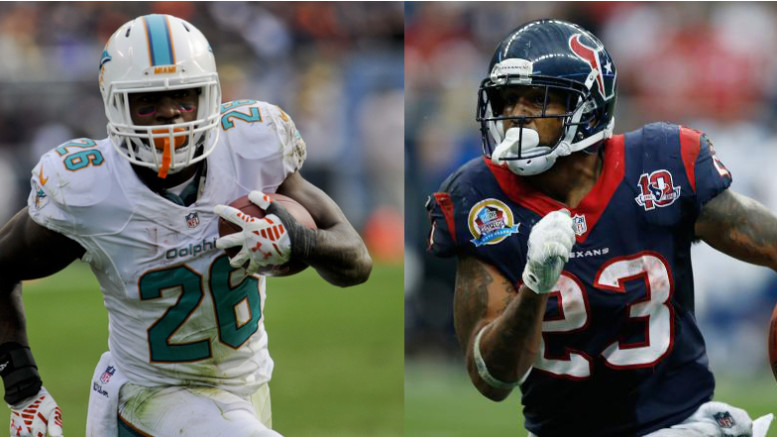For good or bad, “Small Ball” is Miami’s mode of operation with this front office.
The “swap” of Lamar Miller and Arian Foster is a snapshot of the Miami Dolphins new team building concept of “Small Ball”.
“Small Ball” is the death by a thousand cuts version of building an NFL team and is fast becoming “all the rage”.
Miami’s front office philosophy for some time has been the team building concept of smashing it out of the park with home runs moves…most of which were abysmal failures.
Those days are gone.
The instant reaction might be that Miami lost on this move: Miller trumps Foster – ‘same ole’ crappy Dolphins’.
I beg to differ.
Yes, on face value, Miller is a better asset than Foster when comparing player verse player – it doesn’t take a great sportsbook to figure that out. But, from a team building concept this might not be the case.
Despite what you hear from ESPN, teams win rings. Not even the best QB’s, in all their glory, win without a team. A team has its talent acquisition and talent retention restricted by the cap – there’s only so much money to go around.
Modern teams are judged on their dollar / production ratio and the value of that ratio equals the acumen of a team’s front office.
So, if you add up all of Miami’s backs you get roughly $4.6 million (Williams $601,168, Drake $655,315, Pead $675,000, Ajayi $580,203, Thomas $600,000, Foster 1.5 million) – nearly a million less than Millers contract alone which is $5.5 million. That number will drop when Thomas gets cut to $4 million and $3.3 million if Pead gets cut. And if Foster meets all of his performance incentives, the whole unit’s salary will balloon to $5.3 million. Given that the cap is $155 million, Miller counts as 2.5% of the Texans cap, the same percentage as Miami’s whole backfield, if Foster has a monster year.
“Small Ball” creates many opportunities in the hopes of finding a few gems.
So, Miller would need to equal the entire backfield’s production to get the winning end of the value ratio if Foster meets all of his incentives, or Miller must out perform them if Foster doesn’t.
From the Texans standpoint, if Miller displays at a dominant talent, even if that ratio in not balanced, then the Texans would still have made the right move given their belief they are “close”. Top talent that dominates games is always worth acquiring, even at a premium, if a team is “close”. But, Miller must play at an elite level with very little down time due to injury because other areas will have to be sacrificed in order to adsorb his contract..
From Miami’s standpoint, they don’t have all their eggs in one basket and aren’t hamstrung by a single injury. They aren’t bound to any big contracts and have full freedom to head in any direction going forward. They have plenty of extra money to invest on their own players, which wasn’t the case at the beginning of this off season and is one reason why Miller was allowed to depart. Lastly, Miami has two backs, maybe three depending on Drake, that are every-down backs.
The Texans felt they were few pieces away and swung for the fences.
Miami wanted to affect the present while keeping and eye on the future – both of which needed cap responsibility.
The Texans must have success with Miller or they will suffer greatly.
The Dolphins with have a tasty cherry with Fosters success and little or no damage if he doesn’t.
So, in summation, as you make your judgement on this “swap”, consider the whole backfield’s production in comparison to Miller’s production as the season progresses. “Small Ball” has come to Miami – the results will soon be apparent. Go Fins!!!

